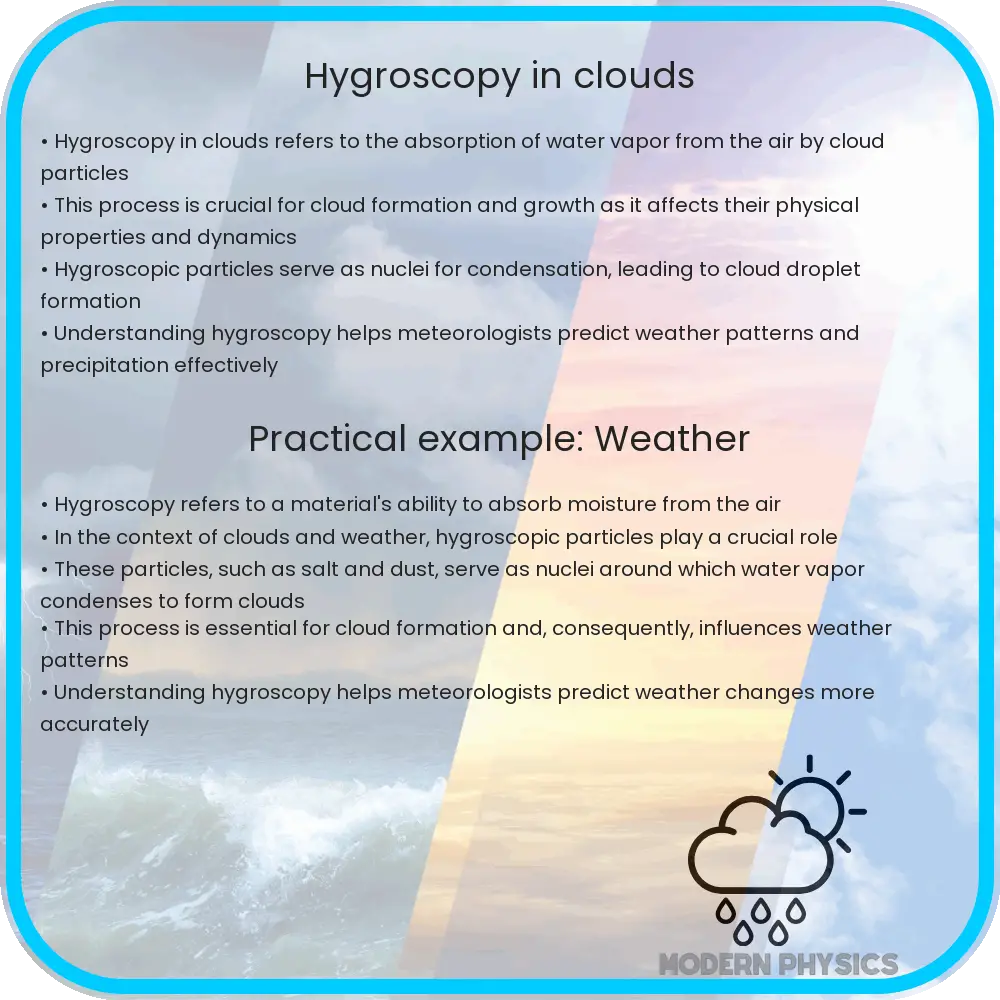Learn about hygroscopy, the process of attracting and holding water molecules, crucial for cloud formation and weather prediction.

Understanding Hygroscopy in Cloud Formation
Hygroscopy refers to the ability of substances to attract and hold water molecules from the surrounding environment. This process is a fundamental aspect in the formation and development of clouds, which play a critical role in weather patterns and prediction. By understanding hygroscopy, scientists are better equipped to analyze and forecast weather changes, providing crucial information for agriculture, disaster management, and daily life planning.
Role of Hygroscopic Materials in Cloud Formation
In the context of cloud formation, certain particles in the atmosphere, known as cloud condensation nuclei (CCN), have hygroscopic properties which make them pivotal in cloud development. These nuclei can be composed of various substances such as salt, dust, and soot, with each type of particle having different hygroscopic levels and therefore different abilities to induce cloud formation.
When hygroscopic particles are present in the atmosphere, they absorb water vapor. As the vapor pressure around these particles increases, they become centers of water condensation. This process is crucial for the transition of water vapor into liquid water droplets, leading to the formation of clouds.
How Hygroscopic Particles Influence Weather Patterns
The concentration and distribution of hygroscopic particles in the atmosphere can significantly impact local and global weather patterns. Areas with higher concentrations of hygroscopic CCN tend to have more cloud cover due to enhanced cloud formation capabilities. This increased cloudiness can affect local climate conditions – for instance, more clouds generally lead to lower temperatures because clouds reflect sunlight back into space.
Moreover, by influencing the density and height of clouds, hygroscopic particles can affect precipitation patterns. Clouds with higher concentrations of hygroscopic particles are more likely to release precipitation, as these particles facilitate the growth of larger water droplets that are more likely to fall as rain or snow. This is particularly crucial in predicting rainfall in arid regions where predictive accuracy can significantly impact water resources management.
Hygroscopicity and Cloud Microphysics
At a micro level, the behavior of hygroscopic particles is a key topic of study in cloud microphysics. Scientists examine how these particles absorb water and grow over time, affecting the cloud’s optical properties and lifetime. The ability of a cloud to reflect, absorb, or transmit solar radiation is directly influenced by these microscopic processes, affecting temperature and climate dynamics at the macro scale.
Various tools and techniques, such as satellite imaging and spectroscopy, are used to measure the hygroscopic properties of clouds. These measurements help improve models used for weather forecasting and climate simulation, providing a deeper understanding of the complex interactions within Earth’s atmosphere.
By studying the role of hygroscopic substances in cloud formation, scientists not only enhance our ability to predict weather and understand climate systems but also contribute to more efficient and refined meteorological technologies. This ongoing research continuously uncovers new aspects of hygroscopy in the atmospheric sciences, making it an exciting and ever-evolving field.
Environmental and Agricultural Implications of Hygroscopic Cloud Formation
The implications of hygroscopic cloud formation extend beyond mere weather prediction to profound environmental and agricultural impacts. Areas prone to drought can benefit from the knowledge of hygroscopic particles, as cloud seeding techniques that utilize these particles can potentially induce rainfall. Understanding how different materials’ hygroscopic properties affect cloud formation can thus directly contribute to agricultural practices by managing irrigation requirements and planning crop rotations more effectively.
Furthermore, the role of hygroscopic particles in cloud formation has broader environmental implications. For instance, forest fire smoke, which contains hygroscopic soot particles, might accelerate cloud formation, potentially leading to premature rainfall. This complex interaction highlights the need for comprehensive studies to understand the environmental impacts of hygroscopic particles both in natural and human-made scenarios.
Challenges in Hygroscopic Research and Future Directions
Despite its importance, research into hygroscopy and cloud dynamics faces several challenges. One major challenge is the accurate and precise measurement of hygroscopic properties in varying atmospheric conditions. Technological advancements are needed to improve the resolution and capabilities of instruments used in such measurements.
Another challenge lies in the computer simulation models used to predict weather patterns and cloud dynamics. These models must be continually updated to incorporate new research findings about the hygroscopic properties of materials, which vary widely across different geographical areas and atmospheric conditions.
Looking forward, the field of hygroscopy in cloud formation presents many exciting possibilities. Future research could explore the genetic modification of crops to emit specific hygroscopic particles, potentially giving rise to clouds and influencing local weather patterns beneficially for agriculture. Additionally, more in-depth studies into the role of urban pollution’s hygroscopic particles could lead to better urban planning and pollution control strategies that consider their impact on local climates.
Conclusion
Understanding hygroscopy’s role in cloud formation is indispensable in meteorology and climate science. Hygroscopic particles, essential in determining the macroscopic weather patterns and microphysical characteristics of clouds, offer insight into precipitation patterns, climate dynamics, environmental management, and agricultural planning. As research progresses, it holds the promise of integrating deeper into various scientific and practical applications, providing the blueprint for future innovations in weather modification and environmental conservation strategies. This wide-ranging impact underscores the importance of investing in and continuing research in this dynamic and crucial field of atmospheric science.
